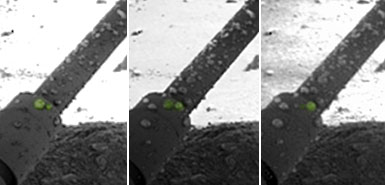
Droplets on a leg of the Mars Phoenix Lander which scientists believe are made of water (NASA/JPL-Caltech/University of Arizona/Max Planck Institute)
Pictures beamed back from Mars appear to provide the first photographic evidence of water existing in its liquid state on the planet.
Shots of Nasa’s Mars Phoenix Lander’s leg struts appear to show droplets of water forming and then vanishing as if they have dripped on to the ground.
The find, if confirmed, has important implications for the chances of there being life forms, however small or primitive, on Mars.
Related article: Phoenix Lander sees snow falling on Mars
Professor Nilton Renno, of the University of Michigan, is convinced the photographs show water droplets forming. It had previously been thought that Mars was so cold and the atmospheric pressure so low that water would exist only as ice or vapour.
Professor Renno led analysis that suggested the water droplets may have been prevented from freezing because they had absorbed salty chemicals which act as anti-freeze.
Tests carried out by the Mars Phoenix Lander uncovered the presence of perchlorate salts, probably including magnesium and calcium perchlorate hydrates, which freeze at minus 68C and minus 77C.
Temperatures at the landing site ranged from minus 20C to minus 140C, but the median temperature was above minus 60C while the craft was operational from May to November last year. This meant there could be pockets of water at the landing site and other parts of the planet which were too salty to freeze for much of the year.
Professor Renno said that thermodynamic calculations predicted droplet growth at the same rate as was observed on the lander’s structs.
Astronomers studying the phenomenon believe the droplets began forming when the space craft landed, with the rockets controlling the landing melting the top layer of ice. Dirt that splashed on to the struts may later have absorbed more water from vapour in the atmosphere, allowing the droplets to get larger.
The possibility of there being water in liquid form at the surface of Mars has implications for the search for life on the planet because bacterial lifeforms have already shown themselves to be capable of surviving on Earth in similarly chilly and salty conditions.
“Liquid water is an essential ingredient for life. This discovery has important implications to many areas of planetary exploration, including the habitability of Mars,” Professor Renno said.
“A large number of independent physical and thermodynamical evidence shows that saline water may actually be common on Mars.”
The results of the analysis are to be presented to a conference in Houston at the weekend, where they are likely to be contested.
Dr Michael Hecht, of Nasa’s Jet Propulsion Laboratory, has already voiced doubts that the blobs on the lander’s leg were water droplets. He is also unconvinced by the suggestion that salts are keeping water in liquid form.
Water on Mars
November 2006: Images taken in 2005 and 2006 and compared to pictures taken in 1999 and 2001 by Mars Global Surveyor suggest water flowed in the intervening periods.
March 2007: Mars Express confirms large quantities of ice are present at the south pole. If it all melted the planet would be under 33 feet of water.
August 2008: Nasa researchers announce that Phoenix has confirmed the presence of ice. It is the first probe to “taste and touch” water on Mars, they say.
November 2008: Mars Reconnaissance Orbiter detects vast glaciers extending dozens of miles under rocky debris much further from the poles than expected.
March 18, 2009
Lewis Smith, Science Reporter
Source: Times Online